Comments / Questions (221)
![]() Giulia wrote:
Giulia wrote:
Salve, non ho capito se devo fare le prime diminuzioni dello sprone subito al primo giro successivo a quello in cui ho unito maniche, davanti/dietro oppure dopo i 2 e 4 giri indicati rispettivamente per davanti/dietro e maniche. La prima diminuzione del dietro per esempio è al secondo giro (nel primo ho unito il lavoro) o al quarto? Grazie
21.10.2025 - 22:35DROPS Design answered:
Buonasera Giulia, può iniziare sul 1° giro e poi continuare come indicato. Buon lavoro!
23.10.2025 - 00:30
![]() Danitza wrote:
Danitza wrote:
Hola, realmente no entiendo como realizar la elevación de la espalda, la he tejido y desarmado muchas veces y no me resulta. No entiendo donde hacer las 8 disminuciones en cada vuelta del derecho, en la espalda? En las mangas? Estoy muy frustrada, siempre uso sus patrones, hace muchos años, y nunca había tenido difucultad para comprenderlos. Estoy tejiendo la talla xl Muchas gracias
20.10.2025 - 03:07
![]() Christine wrote:
Christine wrote:
Bonjour, j\'avance mais c\'est laborieux! Je suis à la réhausse et je ne comprends pas. J\'ai fait les 78 mailles. Les 58 du rang suivant sont en revenant sur ces 78 ou en continuant? La réhausse est dans le dos? désolée pour ces questions de débutante.
24.09.2025 - 23:18DROPS Design answered:
Bonjour Christine, avant la réhausse, tricotez d'abord les 78 premières mailles à partir du début du tour; les rangs raccourcis de la réhausse vont commencer ici (entre A.2 et la manche droite). Au rang suivant = sur l'endroit, tricotez les 58 premières mailles en diminuant pour le raglan (cf DIMINUTIONS RAGLAN (RÉ-HAUSSE):), tournez et tricotez sur l'envers 48 mailles, tournez et tricotez sur l'endroit 46 mailles en diminuant pour le raglan, tournez et tricotez 36 mailles sur l'envers = il reste 80 mailles. Tricotez maintenant de nouveau en rond, en côtes pour le col. Bon tricot!
30.09.2025 - 16:43
![]() Rossella wrote:
Rossella wrote:
Indicativamente si potrebbero avere le misure in cm della lunghezza delle maniche e del maglione nei modelli L e XL? Giusto per non sbagliare la misura. Grazie
20.09.2025 - 09:52DROPS Design answered:
Buonasera Rossella, in fondo alla pagina di ogni modello può trovare lo schema con le misure. Buon lavoro!
22.09.2025 - 01:03
![]() Giulia wrote:
Giulia wrote:
Salve, sto 'studiando' il modello prima di iniziare e non ho capito bene a cosa serve la cosiddetta 'alzata per lo scollo', i 4 giri con i ferri accorciati che parte del lavoro interessano? Non riesco a capire perché di solito i ferri accorciati si usano per far crescere solo una parte del lavoro ma in questo caso guardando il numero di maglie totali e quelle coinvolte nei 4 giri non riesco a capire la necessità.
12.09.2025 - 11:02DROPS Design answered:
Buongiorno Giulia, solitamente l'alzata si lavora sul dietro del collo per dare maggiore vestibilità. Buon lavoro!
14.09.2025 - 09:35
![]() Christine wrote:
Christine wrote:
Bonjour, je ne comprends pas la différence entre raglan dos/devant et raglan manches? merci de m'expliquer, je suis bloquée!
11.09.2025 - 22:13DROPS Design answered:
Bonjour Christine, vous diminuez pour le raglan dos/devant apres les marqueurs 1 et 3 et avant les marqueurs 2 et 4 (4 mailles diminuees). Vous diminuez pour le raglan manches apres les marqueurs 2 et 4 et avant les marqueurs 1 et 3 (4 mailles diminuees). Donc parfois vous allez diminuez 4 mailles par tour, et parfois 8 mailles par tour. Bon tricot!
12.09.2025 - 08:50
![]() Anja wrote:
Anja wrote:
Kann man dieses Garn bzw den Pulli aus "Nepal" eventuell auch in der Waschmaschine waschen, Wollprogramm, kalt oder max. 30 Grad? Ich finde Handwäsche so mühsam🙂 LG Anja
29.08.2025 - 22:54DROPS Design answered:
Liebe Anja, folgen Sie immer am besten die Pflegehinweise der Banderolle - hier lesen Sie mehr. Wenn Sie lieber eine Superwash Wolle stricken möchten, dann finden Sie hier einige, die Sie anstatt stricken können (benutzen Sie den Garnumrechner für die neue Garnmenge kalkulieren zu lassen). Viel Spaß beim Stricken!
01.09.2025 - 17:01
![]() Marie-Claire Van Aert wrote:
Marie-Claire Van Aert wrote:
Herentrui drops 174-14 Bij raglan mindering ( ronding) moet je minderen door 3 steken samen te breien. Dan heb je geen steken genoeg . Bij 2 steken samenbreien klopt t aantal! Os dit fout in patroon? Ik denk t.
31.07.2025 - 20:15DROPS Design answered:
Dag Marie-Claire,
Voor en na de raglan brei je steeds 2 steken samen. Het samenbreien van 3 steken geldt alleen voor de verhoging aan de achterkant van de hals, die je maakt nadat de (gewone) raglanmeerderingen klaar zijn.,
31.07.2025 - 20:57
![]() Christine wrote:
Christine wrote:
Je crois que j'ai compris mon questionnement : il est tricoté de bas en haut c'est ça?
09.06.2025 - 21:30DROPS Design answered:
Bonjour Christine, tout à fait, ce pull se tricote de bas en haut. Bon tricot!
10.06.2025 - 09:30
![]() Christine wrote:
Christine wrote:
Bonjour, j'ai monté 192 mailles pour la taille XL mais le col me semble beaucoup trop large! Est-ce le bon compte? merci!!!
09.06.2025 - 21:18DROPS Design answered:
Bonjour Christine, tout à fait surtout si votre tension / échantillon (17 m x 24 rangs en point fantaisie A.1) est juste. Notez bien qu'au début, on tricote en côtes, il faut donc davantage de mailles car les côtes resserrent l'ouvrage. Après les côtes, vous devriez avoir 56 cm de large si votre tension est juste (soit environ 112 cm de circonférence). Bon tricot!
10.06.2025 - 09:29
Twin River#twinriversweater |
|||||||
 |
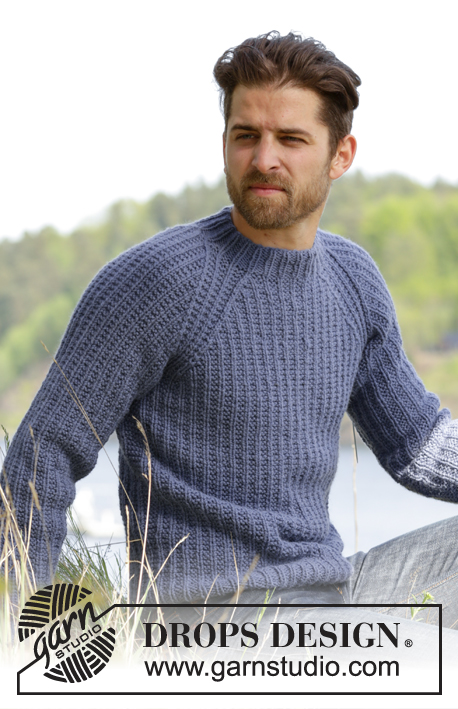 |
||||||
Knitted DROPS men’s jumper with textured pattern and raglan in Nepal. Size: S - XXXL.
DROPS 174-14 |
|||||||
|
PATTERN: See diagrams A.1 and A.2. RAGLAN: Dec as follows before A.2: Work until 2 sts remain before A.2, K the next 2 tog. Dec as follows after A.2: Slip 1 st as if to K, K 1, psso INCREASE TIP (BODY): Inc 4 sts on round as follows: Work until 1 st remains before marker in the side, 1 YO, work 2 sts in garter st, 1 YO (= 2 sts inc). Repeat inc in the other side of piece. On next round work YO twisted to avoid holes. Work the new sts in garter st. INCREASE TIP (SLEEVE): Inc as follows mid under sleeve: Work until 1 st remains before marker, 1 YO, work 2 sts in garter st, 1 YO. On next round work YO twisted to avoid holes. Work the inc sts gradually in the pattern. NOTE: Work sts on each side of marker in garter st. RAGLAN DEC (ELEVATION): All dec are done from RS! Dec as follows after A.2: K 3 twisted tog. Dec as follows before A.2: Work until 3 sts remain before A.2, K 3 tog. ---------------------------------------------------------- JUMPER: Worked in the round. BODY: Cast on 150-162-168-192-210-234 sts with Nepal on circular needle size 5 mm. * P 1, (K 1, P 2), repeat from (-) 23-25-26-30-33-37 more times, K 1, P 1, insert a marker here (= side) *, repeat from *-* 1 more time. NOTE: Move the markers upwards when working. Continue rib in the round like this until piece measures 4 cm. Now work pattern A.1 as follows: Work the last 2 sts in A.1, then repeat A.1 the entire round until 1 st remains on round, work the first st in A.1. REMEMBER THE KNITTING TENSION When piece measures 13-13-14-14-15-15 cm, inc 1 st on each side of each marker – see INCREASE TIP (BODY). Repeat inc when piece measures 27-28-29-29-30-30 cm = 158-170-176-200-218-242 sts. When piece measures 41-41-42-42-42-42 cm (adjust so that next round worked is 2nd round in A.1), cast off sts for armholes as follows: Cast off the first 5 sts on round, work the next 69-75-78-90-99-111 sts, cast off the next 10 sts for armhole, work the next 69-75-78-90-99-111 sts, cast off the remaining 5 sts. Cut the yarn. Put piece aside and knit the sleeves. SLEEVE: Work sleeves in the round on double pointed needles. Cast on 42-42-42-48-48-48 sts with Nepal on double pointed needles size 5 mm. Insert a marker at beg of round = mid under sleeve. Work rib as follows: P 1, K 1, * P 2, K 1 *, repeat from *-* until 1 st remains on round, P 1. Continue like this in the round until rib measures 4 cm. Now work pattern as follows: Work the last 2 sts in A.1, A.1 until 1 st remains on round, work the first st in A.1. When piece measures 9-8-7-6-10-9 cm, inc 1 st on each side of marker – see INCREASE TIP (SLEEVE). Inc like this approx. every 13th-9th-7th-7th-6th-5th round 8-11-14-14-14-17 times in total = 58-64-70-76-76-82 sts. When piece measures 51-50-49-48-47-46 cm - adjust so that next round worked is 2nd round in A.1, cast off the middle 10 sts under sleeve (= 5 sts on each side of marker) = 48-54-60-66-66-72 sts. Knit another sleeve the same way. YOKE: Slip sleeves on to same circular needle size 5 mm as body where armholes were cast off = 234-258-276-312-330-366 sts. This is done without working the sts. Insert a marker in every transition between sleeves and body = 4 markers. Beg round on back piece, 4 sts after marker between sleeve and back piece. Now continue pattern as before and work in addition A.2 (= 8 sts) in every transition between body and sleeves (markers are in the middle of A.2). On next round start dec for RAGLAN – see explanation above! NOTE: Dec differently on body and sleeves as follows: RAGLAN BODY: Dec every other round 21-24-24-24-26-26 times and then every round 0-0-0-6-7-13 times (= 21-24-24-30-33-39 times in total). RAGLAN SLEEVES: Dec every 4th round 6-6-4-3-5-5 times and then every other round 9-12-17-21-19-22 times (= 15-18-21-24-24-27 times in total). When all dec are done, 90-90-96-96-102-102 sts remain on round (= 144-168-180-216-228-264 sts in total dec). Now work pattern as before over the first 72-72-78-78-84-84 sts. Insert marker here (= between A.2 and right sleeve). Then work an elevation back and forth in neck in pattern as before AT THE SAME TIME dec for raglan on every row from RS over the sts worked – READ RAGLAN DEC (ELEVATION) as follows: NOTE: Tighten yarn at every turn to avoid holes. ROW 1 (= RS): Work 55-55-58-58-61-61 sts (including the 8 dec sts), ROW 2 (= WS): Turn and work 45-45-48-48-51-51 sts, ROW 3: Turn and work 43-43-46-46-49-49 sts (including the 8 dec sts), ROW 4: Turn and work 33-33-36-36-39-39 sts. There are now 74-74-80-80-86-86 sts on round. Turn and continue in the round with rib as follows: Work K over K and P over sts in garter st until rib measures 4 cm. Cast off sts with K over K and P over P. Jumper measures 64-66-68-70-72-74 cm from cast-on edge and up to shoulder. Fasten off. ASSEMBLY: Sew the openings under the sleeves. |
|||||||
Diagram explanations |
|||||||
|
|||||||
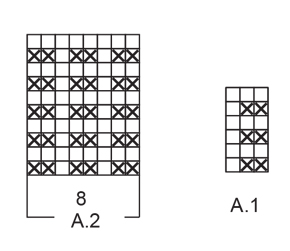 |
|||||||
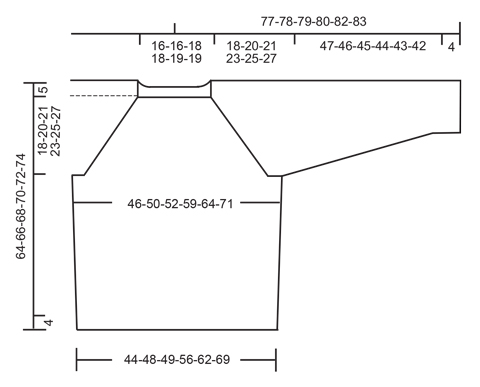 |
|||||||
Have you finished this pattern?Tag your pictures with #dropspattern #twinriversweater or submit them to the #dropsfan gallery. Do you need help with this pattern?You'll find 25 tutorial videos, a Comments/Questions area and more by visiting the pattern on garnstudio.com. © 1982-2025 DROPS Design A/S. We reserve all rights. This document, including all its sub-sections, has copyrights. Read more about what you can do with our patterns at the bottom of each pattern on our site. |
|||||||







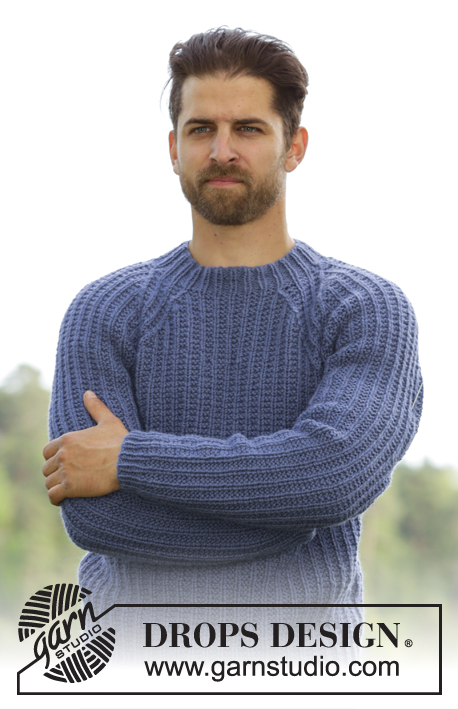
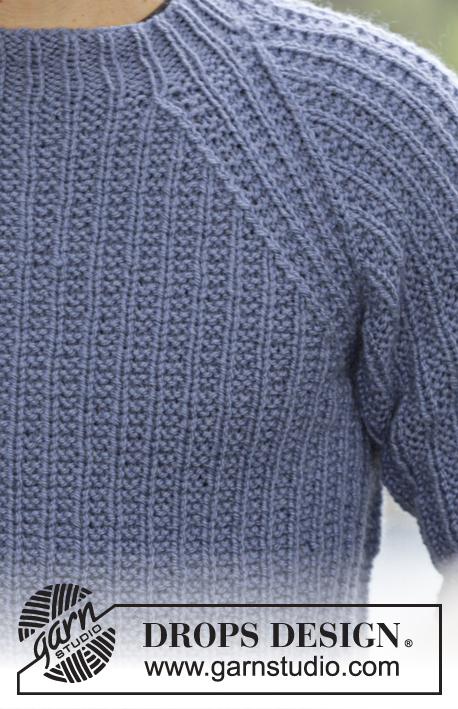

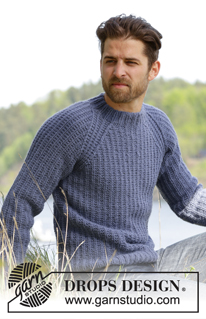
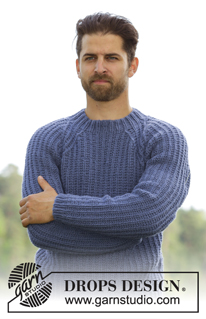
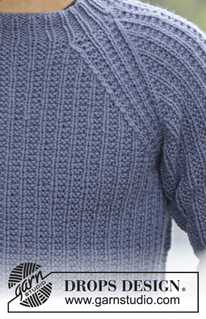





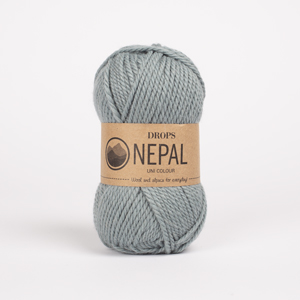
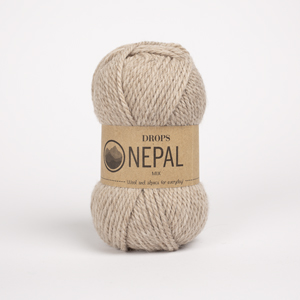


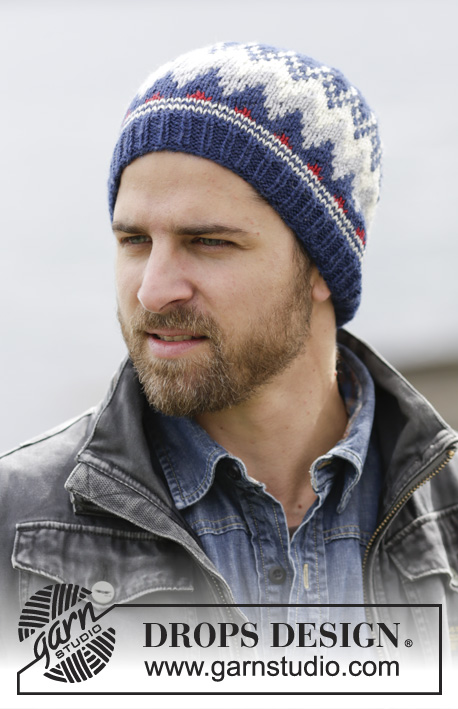

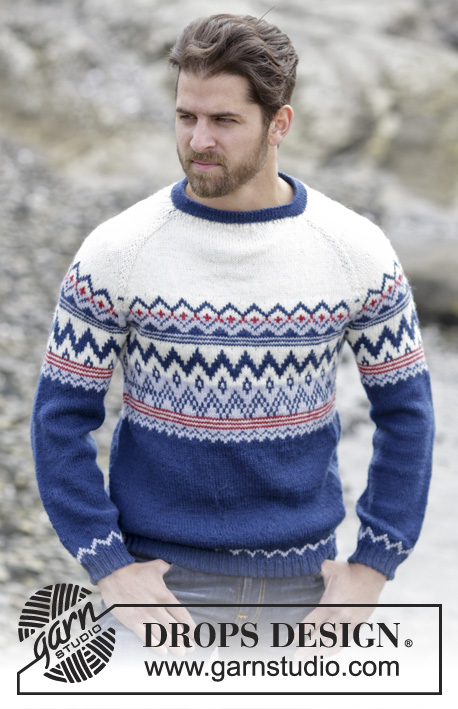











































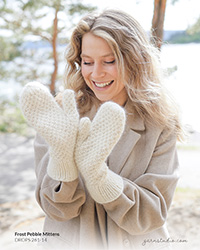

Post a comment to pattern DROPS 174-14
We would love to hear what you have to say about this pattern!
If you want to leave a question, please make sure you select the correct category in the form below, to speed up the answering process. Required fields are marked *.